Hermann Bauer was a German naval officer who served as commander of the U-boat forces of the Kaiserliche Marine during World War I. In addition to his World War I career, Bauer is well known as the author of the book Das Unterseeboot, a treatise on the design and operation of U-boats, which was later translated into English by Hyman G. Rickover. Rickover's translation became a basic text for the US submarine service.
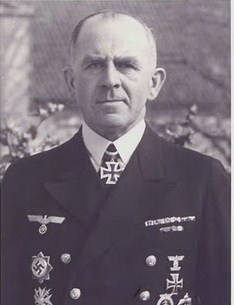
Otto Ciliax was a German naval officer who served in the navies of the German Empire, the Weimar Republic and Nazi Germany. As an admiral during World War II, he commanded the German battleships. He was a recipient of the Knight's Cross of the Iron Cross.

The Roon class was a pair of armored cruisers built for the German Kaiserliche Marine in the 1900s. The two ships of the class, Roon and Yorck, closely resembled the earlier Prinz Adalbert-class cruisers upon which they were based. The Roon class incorporated slight incremental improvements, including a pair of extra boilers. The ships were easily distinguished from their predecessors by the addition of a fourth funnel. Though the additional boilers were meant to increase the ships' speed, both vessels failed to reach their designed top speed. In addition, the ships had comparatively light armament and thin armor protection, so they compared poorly with their foreign contemporaries, particularly the armored cruisers of their primary opponent, the British Royal Navy.

SMS Roon was the lead ship of her class of armored cruisers built for the German Kaiserliche Marine in the early 1900s as part of a major naval expansion program aimed at strengthening the fleet. The ship was named after Field Marshal Albrecht von Roon. She was built at the Kaiserliche Werft in Kiel, being laid down in August 1902, launched in June 1903, and commissioned in April 1906. The ship was armed with a main battery of four 21 cm (8.3 in) guns and had a top speed of 20.4 knots. Like many of the late armored cruisers, Roon was quickly rendered obsolescent by the advent of the battlecruiser; as a result, her career was limited.

The Prinz Adalbert class was a group of two armored cruisers built for the German Kaiserliche Marine under the terms of the Second Naval Law. Two ships of the class were built, Prinz Adalbert and Friedrich Carl, between 1900 and 1904. The two ships were heavily based on the previous armored cruiser, Prinz Heinrich, with a series of incremental improvements. Their armor layout was revised slightly to improve internal protection and their main battery consisted of four 21 cm (8.3 in) guns instead of the two 24 cm (9.4 in) carried by Prinz Heinrich. The new ships also received more powerful propulsion systems, making them slightly faster. Prinz Adalbert spent her peacetime career as a gunnery training ship while Friedrich Carl initially served as the flagship of the fleet's reconnaissance forces. By 1909, she had been replaced by more modern cruisers and joined Prinz Adalbert as a training vessel.

SMS Friedrich Carl was a German armored cruiser built in the early 1900s for the German Kaiserliche Marine. She was the second and final member of the Prinz Adalbert class, which were built to serve as scouts for the German fleet and as station ships in Germany's colonial empire. Friedrich Carl was built by the Blohm & Voss shipyard in Hamburg. She was laid down in August 1901, launched in June 1902, and commissioned in December 1903. She was armed with a main battery of four 21 cm (8.3 in) guns and could reach a top speed of 20.4 kn.

SMS Prinz Adalbert was an armored cruiser built in the early 1900s for the German Kaiserliche Marine, named after Prince Adalbert of Prussia, former Commander-in-Chief of the Prussian Navy. She was the lead ship of her class, which included a second ship, Friedrich Carl. Prinz Adalbert was built at the Imperial Dockyard in Kiel. Her keel was laid in April 1900, and she was launched in June 1901. Her completion in January 1904 had been delayed by a surplus of construction projects at the Imperial Dockyard. She was armed with a main battery of four 21 cm (8.3 in) guns, a significant improvement over the previous armored cruiser, Prinz Heinrich, which carried only two 24 cm (9.4 in) guns. The ship was capable of a top speed of 20 kn.

SMS Prinz Heinrich was a unique German armored cruiser built at the turn of the 20th century for the German Kaiserliche Marine, named after Kaiser Wilhelm II's younger brother Prince Heinrich. The second vessel of that type built in Germany, Prinz Heinrich was constructed at the Kaiserliche Werft in Kiel, being laid down in December 1898, launched in March 1900, and commissioned in March 1902. Prinz Heinrich's design was a modification of the previous armored cruiser, Fürst Bismarck, and traded a smaller main battery and thinner armor for higher speed. All subsequent German armored cruisers were incremental developments of Prinz Heinrich.

Hans-Jürgen "Hansjürgen" Rudolf Reinicke was a Kapitän zur See, commander of heavy cruiser Prinz Eugen, in Nazi Germany's Kriegsmarine during the Second World War and recipient of the Knight's Cross of the Iron Cross.

SMS Danzig was a light cruiser of the Imperial German Navy. Named for the city of Danzig, she was the seventh and last ship of the Bremen class. She was begun by the Imperial Dockyard in her namesake city in 1904, launched on 23 September 1905 and commissioned on 1 December 1907. Armed with a main battery of ten 10.5 cm (4.1 in) guns and two 45 cm (18 in) torpedo tubes, Danzig was capable of a top speed of 22 knots.

SMS Lübeck was the fourth of seven Bremen-class cruisers of the Imperial German Navy, named after the city of Lübeck. She was begun by AG Vulcan Stettin in Stettin in 1903, launched in March 1904 and commissioned in April 1905. Armed with a main battery of ten 10.5 cm (4.1 in) guns and two 45 cm (18 in) torpedo tubes, Lübeck was capable of a top speed of 22.5 knots.
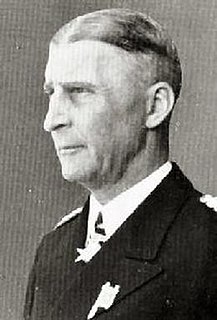
Otto Schultze was a Generaladmiral with the Kriegsmarine during World War II and a recipient of the Pour le Mérite during World War I. The Pour le Mérite was the Kingdom of Prussia's highest military order for German soldiers until the end of World War I. As a U-boat commander during World War I, he was credited with the sinking of 53 merchant ships for a total of 132,567 gross register tons, and HMS Falmouth of 5,275 long tons (5,360 t) displacement.
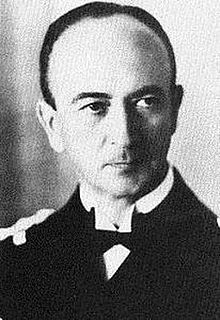
Hermann Boehm was a German naval officer who rose to the rank of General Admiral during the Second World War.
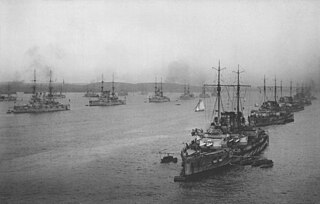
The II Battle Squadron was a unit of the German High Seas Fleet before and during World War I. The squadron saw action throughout the war, including the Battle of Jutland on 31 May – 1 June 1916, where it formed the rear of the German line.
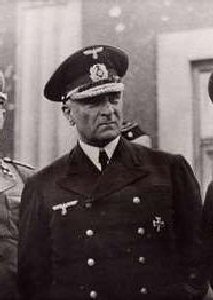
Friedrich Lützow was a German naval officer who served in the Kaiserliche Marine, the Reichsmarine and the Kriegsmarine, eventually reaching the rank of Vizeadmiral during World War II. He was also a writer on naval warfare.
Gustav Bachmann was a German naval officer, and an admiral in World War I.

SMS Prinz Adalbert was a steam corvette of the German Kaiserliche Marine, the second and final member of the Leipzig class. She was laid down in 1875 at the AG Vulcan shipyard in Stettin, was launched in June 1876, and was commissioned into the fleet in August 1877. Originally named Sedan after the Battle of Sedan of the Franco-Prussian War, she was renamed Prinz Adalbert to avoid antagonizing France in 1878, less than a decade after the battle.

The Leipzig class was a group of two steam corvettes built for the German Kaiserliche Marine in the 1870s. The two ships of the class were Leipzig and Prinz Adalbert; Prinz Adalbert was originally named Sedan after the Battle of Sedan, but was renamed shortly after entering service to avoid angering France. They were based on the earlier corvette Freya, but were significantly larger, carried a stronger armament, and unlike the wooden-hulled Ariadne-class corvettes, adopted iron construction, making them the first corvettes of the German fleet to be built with iron. Originally intended to serve abroad and with the fleet, British experiences during the Battle of Pacocha in 1877 convinced the German naval command that unarmored warships were useless against the fleets of ironclads being built by the European navies, and so Leipzig and Prinz Adalbert would be used only on foreign stations.

Guido von Usedom was a German admiral that served in the Boxer Rebellion and World War I. His most notable service was in the Dardanelles Campaign.
















